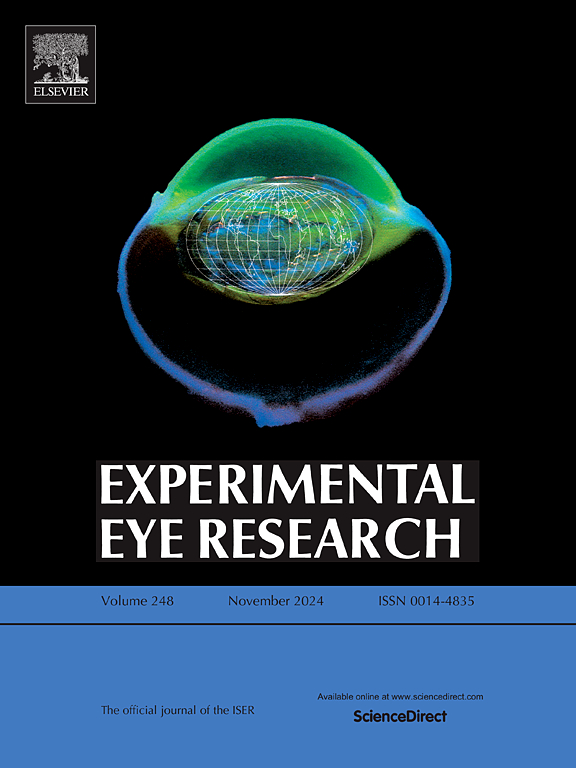机器学习揭示ATM和CNOT6L是白内障发病的关键因素。
IF 3
2区 医学
Q1 OPHTHALMOLOGY
引用次数: 0
摘要
目的:白内障是一种常见的老年性致盲眼病,其发病机制复杂。本研究旨在发现与白内障相关的关键基因和潜在机制,为白内障的预防和治疗提供新的靶点和见解。方法:通过转录组学数据分析和机器学习,确定ATM丝氨酸/苏氨酸激酶(ATM)和CCR4-NOT转录复合体亚单位6样(CNOT6L)为关键差异基因。通过白内障细胞模型的过表达实验验证了它们在氧化应激和细胞凋亡中的作用。免疫相关分析探讨了它们对免疫微环境的调控作用,京都基因与基因组百科全书(KEGG)通路分析揭示了潜在的机制。体外实验考察了ATM和CNOT6L过表达对晶状体上皮细胞增殖、氧化应激和凋亡的影响。结果:我们鉴定出14个与衰老相关的差异表达基因,通过机器学习和外部数据验证筛选出ATM丝氨酸/苏氨酸激酶和CCR4-NOT转录复合物亚基6 like作为关键基因。KEGG通路分析表明它们参与碱基切除修复、ERBB信号传导和脂肪酸代谢途径。免疫浸润分析显示,ATM和CNOT6L与CD8 T细胞和B细胞呈正相关,与调节性T细胞(Tregs)、自然杀伤细胞(NK)和M1巨噬细胞呈负相关。体外,在白内障细胞模型中,过表达ATM和CNOT6L可促进细胞增殖,抑制细胞凋亡,降低活性氧(ROS)和丙二醛(MDA)水平,增强谷胱甘肽过氧化物酶(GSH-PX)活性。结论:ATM和CNOT6L通过降低氧化应激、抑制细胞凋亡、调节免疫微环境等机制对白内障的进展具有保护作用。它们代表了预防和治疗白内障的有希望的分子靶点。本文章由计算机程序翻译,如有差异,请以英文原文为准。
Machine learning Reveals ATM and CNOT6L as critical factors in Cataract pathogenesis
Objective
Cataract, a common age-related blinding eye disease, has a complex pathogenesis. This study aims to identify key genes and potential mechanisms associated with cataracts, offering new targets and insights for its prevention and treatment.
Methods
Transcriptomic data analysis and machine learning identified ATM serine/threonine kinase (ATM) and CCR4-NOT transcription complex subunit 6 like (CNOT6L) as key differential genes. Their roles in oxidative stress and apoptosis were validated using overexpression experiments in a cataract cell model. Immune-related analyses explored their regulatory effects on the immune microenvironment, and Kyoto Encyclopedia of Genes and Genomes (KEGG) pathway analysis revealed potential mechanisms. In addition, in vitro experiments were conducted to evaluate the effects of ATM and CNOT6L overexpression on cell proliferation, oxidative stress, and apoptosis in lens epithelial cells.
Results
We identified 14 aging-associated differentially expressed genes, and ATM and CNOT6L were screened as key genes through machine learning and external dataset validation. KEGG pathway analysis indicated their involvement in base excision repair, ERBB signaling, and fatty acid metabolism pathways. Immune infiltration analysis revealed that ATM and CNOT6L positively correlated with CD8 T cells and B cells, and negatively correlated with regulatory T cells (Tregs), natural killer (NK) cells, and M1 macrophages. In vitro, overexpression of ATM and CNOT6L in cataract cell models promoted cell proliferation, inhibited apoptosis, reduced reactive oxygen species (ROS) and malondialdehyde (MDA) levels, and enhanced glutathione peroxidase (GSH-PX) activity.
Conclusion
ATM and CNOT6L play protective roles in cataract progression by reducing oxidative stress, inhibiting apoptosis, and regulating the immune microenvironment. They represent promising molecular targets for cataract prevention and treatment.
求助全文
通过发布文献求助,成功后即可免费获取论文全文。
去求助
来源期刊

Experimental eye research
医学-眼科学
CiteScore
6.80
自引率
5.90%
发文量
323
审稿时长
66 days
期刊介绍:
The primary goal of Experimental Eye Research is to publish original research papers on all aspects of experimental biology of the eye and ocular tissues that seek to define the mechanisms of normal function and/or disease. Studies of ocular tissues that encompass the disciplines of cell biology, developmental biology, genetics, molecular biology, physiology, biochemistry, biophysics, immunology or microbiology are most welcomed. Manuscripts that are purely clinical or in a surgical area of ophthalmology are not appropriate for submission to Experimental Eye Research and if received will be returned without review.
 求助内容:
求助内容: 应助结果提醒方式:
应助结果提醒方式:


